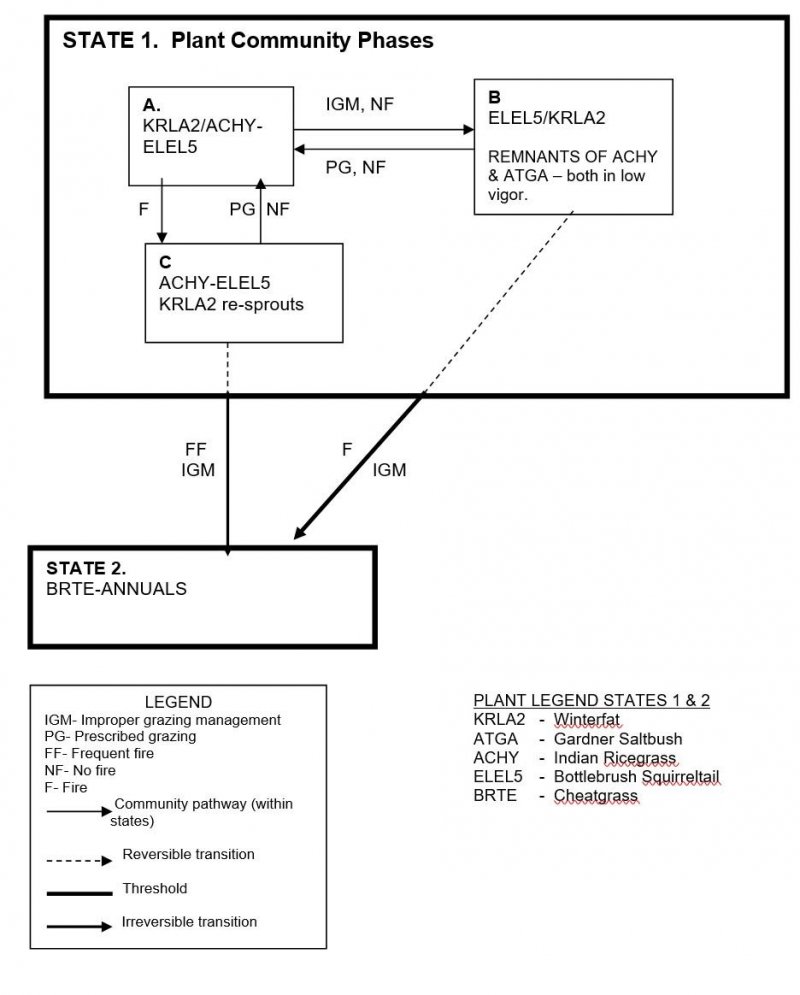Animal community
Wildlife Interpretations.
Animal Community – Wildlife Interpretations
This rangeland ecological site provides a sparse plant community for select native wildlife species. The plant community exhibits a low diversity of grasses, forbs, and shrubs. Mule deer and pronghorn are the large herbivores using the site during spring, summer, and winter months. The site provides seasonal habitat for resident and migratory animals including shrews, ground squirrels, mice, jackrabbits, coyote, red fox, badger, sage-grouse, Ferruginous hawk, prairie falcon, horned lark, and western meadowlark. Area sensitive species may include Great Basin ground squirrel, Idaho pocket gopher, and sage-grouse. Encroachment of noxious and invasive plant species (cheatgrass, Russian thistle, and kochia) in isolated areas can replace native plant species which provide critical feed, brood-rearing, and nesting cover for a variety of native wildlife. Water features are sparse provided by seasonal streams and artificial water catchments.
State 1 Phase 1.1 –Winterfat/ Indian Ricegrass/ Bottlebrush Squirreltail Reference Plant Community (RPC) This plant community provides grasses, forbs, and shrubs used throughout the growing season by native insect communities that assist in pollination. The reptile community is represented by leopard lizard and sagebrush lizard. Sage-grouse may utilize the site on a limited basis for brood-rearing habitat when adjacent to sagebrush cover. The plant community provides forage throughout the year for large mammals including mule deer, elk, bighorn sheep, and pronghorn. Winterfat, Gardner saltbush, and shadscale saltbush provide fair to good feed for deer. Pronghorn utilize the site throughout the year. Winterfat is utilized extensively by rodents, jackrabbits, birds, mule deer, and pronghorn. Rodent populations can be high and provide an excellent prey base for raptors.
State 1 Phase 1.2 – Bottlebrush Squirreltail/ Winterfat Plant Community: This plant community is the result of improper grazing and lack of fire. The plant community is similar to State 1 Phase 1.1, but with low vigor and reduced canopy cover of winterfat and Gardner saltbush. The plant community, dominated by herbaceous vegetation would provide less vertical structure for animals. Insect diversity would be reduced but native forbs are still present and would support select pollinators. Habitat quality for reptiles would be fair for short horned lizard and sagebrush lizard due to the reduction of winterfat, Gardner saltbush, and other native shrubs. The dominant herbaceous vegetation improves habitat for grassland avian species (horned lark and western meadowlark). The reduction of saltbush and winterfat would reduce the quality of the habitat for mule deer and pronghorn. The site would provide poor winter habitat for large mammals. Quality of cover and forage habitat for small mammals would be reduced. The populations of small mammals would be dominated by open grassland species.
State 1 Phase 1.3- Indian Ricegrass/ Bottlebrush Squirreltail/ Winterfat Plant Community: This plant community is the result of fire. The plant community, dominated by herbaceous vegetation would provide less vertical structure for animals. Winterfat and Gardner saltbush would re-sprout adding vertical structure over time. The forbs present would be similar to State 1 Phase 1.1. Diversity of insects and reptiles would be reduced due to the loss of shrubs. The herbaceous vegetation improves habitat for grassland avian species (horned lark and western meadowlark). The decline of Gardner saltbush, winterfat, and shadscale saltbush would lower the quality of habitat for mule deer and pronghorn. Winter habitat for large mammals would be reduced or eliminated. Indian ricegrass provides excellent early spring feed for mule deer and pronghorn. Small mammal diversity and populations may be reduced with the loss of cover and food.
State 2 – Cheatgrass / Annuals Plant Community:
This state has developed due to frequent fires and improper grazing management. The reduced forb and shrub components in the plant community would support a very limited population of pollinators. Most reptilian species are not supported with food, water, or cover. This plant community does not provide the habitat requirements for sage-grouse. Diversity of grassland avian species is reduced due to poor cover and available food. Birds of prey including hawks and falcons may range throughout these areas looking for prey species. Large mammals may utilize the herbaceous vegetation in the early part of the year when the invasive annuals (cheatgrass) are more palatable. At other times of the year large mammals would not regularly utilize these areas due to poor food and cover conditions. The populations of small mammals would be dominated by open grassland species.
Grazing Interpretations.
This site is suited for grazing by domestic livestock in the spring, fall and winter. Natural water supplies are typically very limited or non-existent and livestock water may have to be piped, hauled or otherwise made available.
Estimated initial stocking rate will be determined with the landowner or decision-maker. They will be based on the inventory which includes species, composition, similarity index, production, past use history, season of use and seasonal preference. Calculations used to determine estimated initial stocking rate will be based on forage preference ratings.
Recreational uses
Antelope hunting is the major recreational use of this site and associated sites. The site is open space with flat terrain and low growing vegetation.

